EDU4UET Assessment 2: Understanding English for Teaching Analysis
VerifiedAdded on 2022/11/17
|31
|8362
|314
Homework Assignment
AI Summary
This assignment presents a student's detailed analysis of their own spoken English, focusing on aspects relevant to teaching. The assignment begins with an orthographic transcription of the student's self-introduction, followed by an analysis of coherence, exploring how linguistic and semantic elements contribute to the text's meaning and structure, including cohesive devices and the use of a selfie to enhance coherence. The core of the assignment involves phonetic and phonological analysis, including broad phonemic transcription, syllable identification, primary lexical stress, and intonation contours. The student differentiates between broad and narrow phonemic analyses, illustrating with examples. Furthermore, the assignment examines suprasegmental features, particularly sentence stress, and its impact on meaning. The analysis references relevant literature to support claims, offering a comprehensive exploration of language features important for teaching English.
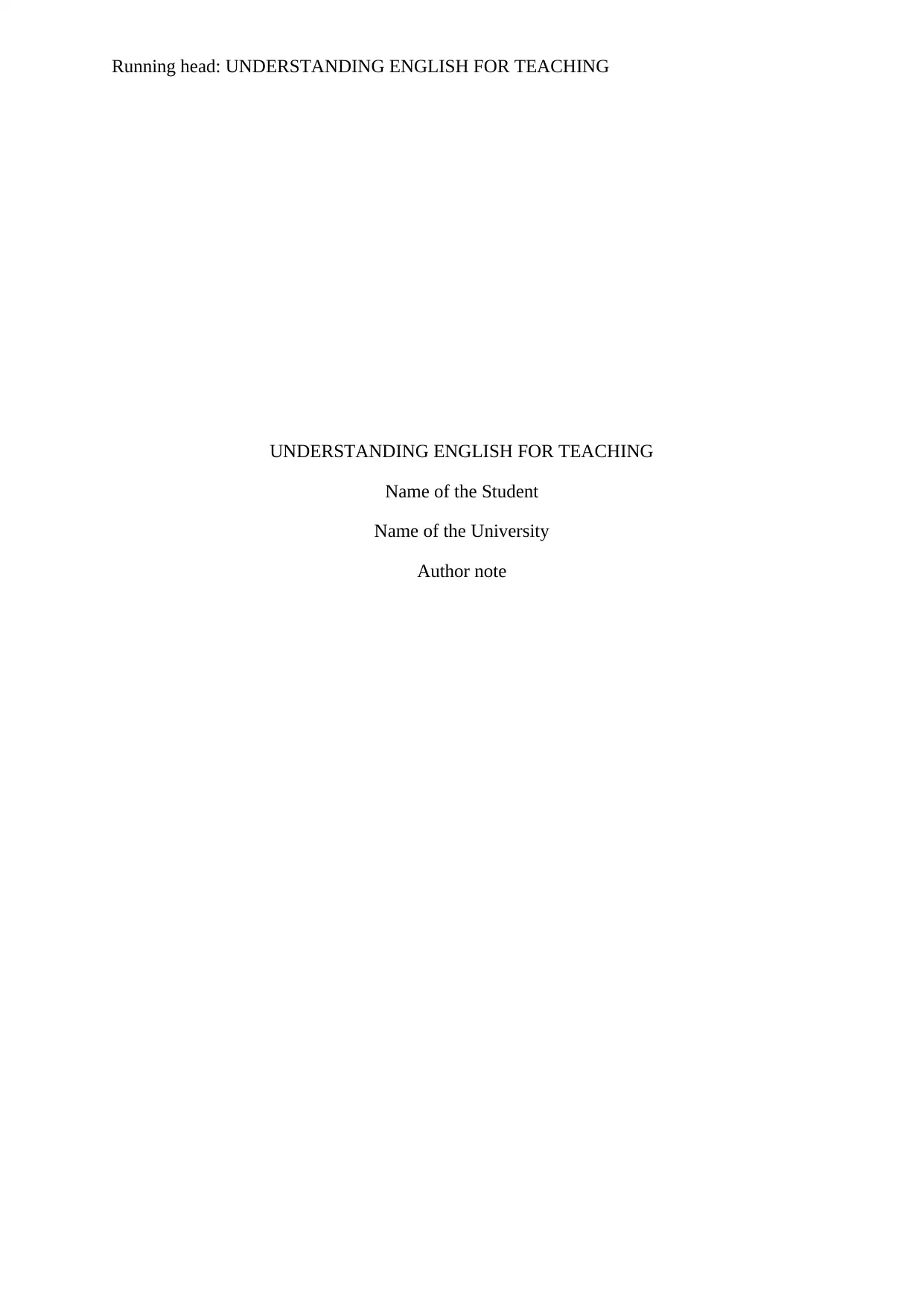
Running head: UNDERSTANDING ENGLISH FOR TEACHING
UNDERSTANDING ENGLISH FOR TEACHING
Name of the Student
Name of the University
Author note
UNDERSTANDING ENGLISH FOR TEACHING
Name of the Student
Name of the University
Author note
Paraphrase This Document
Need a fresh take? Get an instant paraphrase of this document with our AI Paraphraser
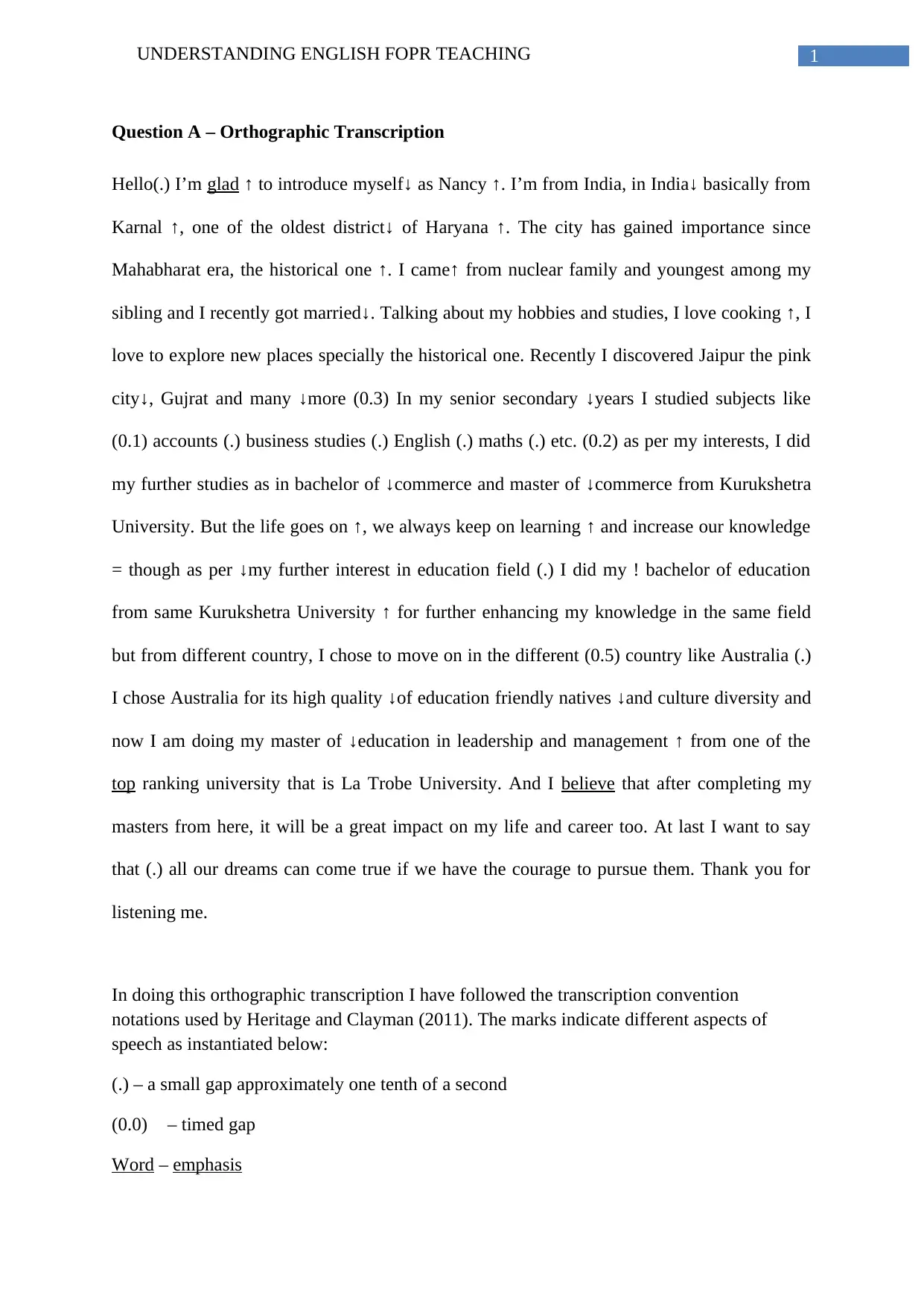
1UNDERSTANDING ENGLISH FOPR TEACHING
Question A – Orthographic Transcription
Hello(.) I’m glad ↑ to introduce myself↓ as Nancy ↑. I’m from India, in India↓ basically from
Karnal ↑, one of the oldest district↓ of Haryana ↑. The city has gained importance since
Mahabharat era, the historical one ↑. I came↑ from nuclear family and youngest among my
sibling and I recently got married↓. Talking about my hobbies and studies, I love cooking ↑, I
love to explore new places specially the historical one. Recently I discovered Jaipur the pink
city↓, Gujrat and many ↓more (0.3) In my senior secondary ↓years I studied subjects like
(0.1) accounts (.) business studies (.) English (.) maths (.) etc. (0.2) as per my interests, I did
my further studies as in bachelor of ↓commerce and master of ↓commerce from Kurukshetra
University. But the life goes on ↑, we always keep on learning ↑ and increase our knowledge
= though as per ↓my further interest in education field (.) I did my ! bachelor of education
from same Kurukshetra University ↑ for further enhancing my knowledge in the same field
but from different country, I chose to move on in the different (0.5) country like Australia (.)
I chose Australia for its high quality ↓of education friendly natives ↓and culture diversity and
now I am doing my master of ↓education in leadership and management ↑ from one of the
top ranking university that is La Trobe University. And I believe that after completing my
masters from here, it will be a great impact on my life and career too. At last I want to say
that (.) all our dreams can come true if we have the courage to pursue them. Thank you for
listening me.
In doing this orthographic transcription I have followed the transcription convention
notations used by Heritage and Clayman (2011). The marks indicate different aspects of
speech as instantiated below:
(.) – a small gap approximately one tenth of a second
(0.0) – timed gap
Word – emphasis
Question A – Orthographic Transcription
Hello(.) I’m glad ↑ to introduce myself↓ as Nancy ↑. I’m from India, in India↓ basically from
Karnal ↑, one of the oldest district↓ of Haryana ↑. The city has gained importance since
Mahabharat era, the historical one ↑. I came↑ from nuclear family and youngest among my
sibling and I recently got married↓. Talking about my hobbies and studies, I love cooking ↑, I
love to explore new places specially the historical one. Recently I discovered Jaipur the pink
city↓, Gujrat and many ↓more (0.3) In my senior secondary ↓years I studied subjects like
(0.1) accounts (.) business studies (.) English (.) maths (.) etc. (0.2) as per my interests, I did
my further studies as in bachelor of ↓commerce and master of ↓commerce from Kurukshetra
University. But the life goes on ↑, we always keep on learning ↑ and increase our knowledge
= though as per ↓my further interest in education field (.) I did my ! bachelor of education
from same Kurukshetra University ↑ for further enhancing my knowledge in the same field
but from different country, I chose to move on in the different (0.5) country like Australia (.)
I chose Australia for its high quality ↓of education friendly natives ↓and culture diversity and
now I am doing my master of ↓education in leadership and management ↑ from one of the
top ranking university that is La Trobe University. And I believe that after completing my
masters from here, it will be a great impact on my life and career too. At last I want to say
that (.) all our dreams can come true if we have the courage to pursue them. Thank you for
listening me.
In doing this orthographic transcription I have followed the transcription convention
notations used by Heritage and Clayman (2011). The marks indicate different aspects of
speech as instantiated below:
(.) – a small gap approximately one tenth of a second
(0.0) – timed gap
Word – emphasis
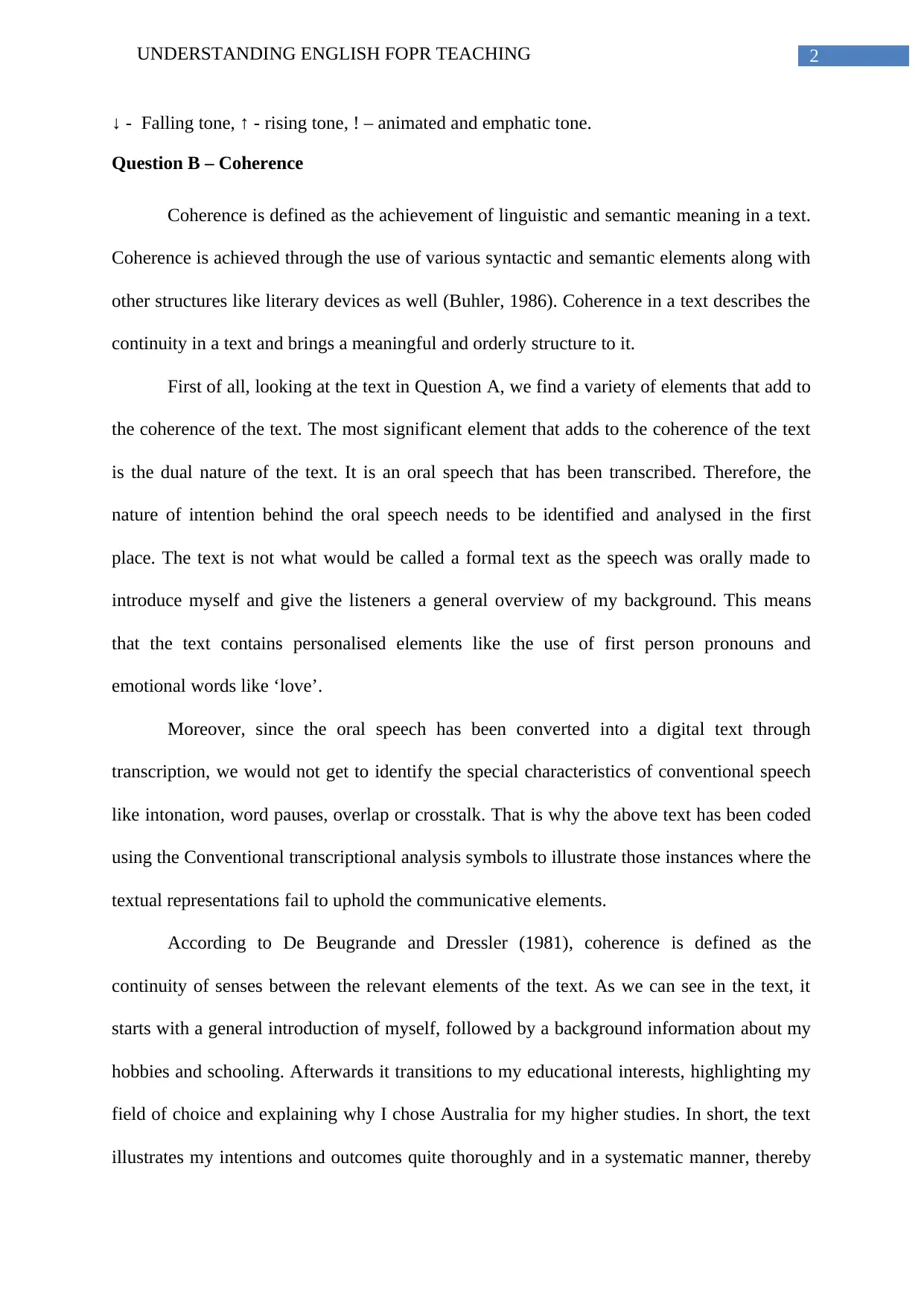
2UNDERSTANDING ENGLISH FOPR TEACHING
↓ - Falling tone, ↑ - rising tone, ! – animated and emphatic tone.
Question B – Coherence
Coherence is defined as the achievement of linguistic and semantic meaning in a text.
Coherence is achieved through the use of various syntactic and semantic elements along with
other structures like literary devices as well (Buhler, 1986). Coherence in a text describes the
continuity in a text and brings a meaningful and orderly structure to it.
First of all, looking at the text in Question A, we find a variety of elements that add to
the coherence of the text. The most significant element that adds to the coherence of the text
is the dual nature of the text. It is an oral speech that has been transcribed. Therefore, the
nature of intention behind the oral speech needs to be identified and analysed in the first
place. The text is not what would be called a formal text as the speech was orally made to
introduce myself and give the listeners a general overview of my background. This means
that the text contains personalised elements like the use of first person pronouns and
emotional words like ‘love’.
Moreover, since the oral speech has been converted into a digital text through
transcription, we would not get to identify the special characteristics of conventional speech
like intonation, word pauses, overlap or crosstalk. That is why the above text has been coded
using the Conventional transcriptional analysis symbols to illustrate those instances where the
textual representations fail to uphold the communicative elements.
According to De Beugrande and Dressler (1981), coherence is defined as the
continuity of senses between the relevant elements of the text. As we can see in the text, it
starts with a general introduction of myself, followed by a background information about my
hobbies and schooling. Afterwards it transitions to my educational interests, highlighting my
field of choice and explaining why I chose Australia for my higher studies. In short, the text
illustrates my intentions and outcomes quite thoroughly and in a systematic manner, thereby
↓ - Falling tone, ↑ - rising tone, ! – animated and emphatic tone.
Question B – Coherence
Coherence is defined as the achievement of linguistic and semantic meaning in a text.
Coherence is achieved through the use of various syntactic and semantic elements along with
other structures like literary devices as well (Buhler, 1986). Coherence in a text describes the
continuity in a text and brings a meaningful and orderly structure to it.
First of all, looking at the text in Question A, we find a variety of elements that add to
the coherence of the text. The most significant element that adds to the coherence of the text
is the dual nature of the text. It is an oral speech that has been transcribed. Therefore, the
nature of intention behind the oral speech needs to be identified and analysed in the first
place. The text is not what would be called a formal text as the speech was orally made to
introduce myself and give the listeners a general overview of my background. This means
that the text contains personalised elements like the use of first person pronouns and
emotional words like ‘love’.
Moreover, since the oral speech has been converted into a digital text through
transcription, we would not get to identify the special characteristics of conventional speech
like intonation, word pauses, overlap or crosstalk. That is why the above text has been coded
using the Conventional transcriptional analysis symbols to illustrate those instances where the
textual representations fail to uphold the communicative elements.
According to De Beugrande and Dressler (1981), coherence is defined as the
continuity of senses between the relevant elements of the text. As we can see in the text, it
starts with a general introduction of myself, followed by a background information about my
hobbies and schooling. Afterwards it transitions to my educational interests, highlighting my
field of choice and explaining why I chose Australia for my higher studies. In short, the text
illustrates my intentions and outcomes quite thoroughly and in a systematic manner, thereby
⊘ This is a preview!⊘
Do you want full access?
Subscribe today to unlock all pages.

Trusted by 1+ million students worldwide

3UNDERSTANDING ENGLISH FOPR TEACHING
keeping the semantic coherence intact. I have used various cohesive devices like conjunctions
to mark the transmission from one aspect of the text to another without breaking flow. This
indicates that the text has also maintained its syntactic coherence.
Apart from just the text, I have also provided a selfie of myself, which I think adds to
the aspect of coherence. The picture is a very plain picture of my face without any additional
digital filters or artificial enhancements. This picture portrays that the originality of the
person in the picture is upheld. Therefore it adds to the coherence of the text.
In conclusion, I would like to state that the present educational field is slowly moving
away from the traditional textbook conventions and entering a digitised curriculum sphere.
Therefore using digital media in education can function as a significant benefactor for the
students. Motteram (2013) highlights that a digital media can have a manifold use in the field
of education provision. Even if we take the example of a digitised text for teaching english,
many Artificial Intelligence based software are developed and implemented that can read a
text with proper pronunciation, and can be useful for teaching phonetics. Similarly, there are
softwares like Grammarly which can highlight the correctness and errors in a grammatical
construction. This can be used for teaching linguistic rules as well as syntax to the children.
Moreover, there are online data storage and sharing domains that has made sharing tasks
easier. Therefore even assessing a task is made more feasible.
keeping the semantic coherence intact. I have used various cohesive devices like conjunctions
to mark the transmission from one aspect of the text to another without breaking flow. This
indicates that the text has also maintained its syntactic coherence.
Apart from just the text, I have also provided a selfie of myself, which I think adds to
the aspect of coherence. The picture is a very plain picture of my face without any additional
digital filters or artificial enhancements. This picture portrays that the originality of the
person in the picture is upheld. Therefore it adds to the coherence of the text.
In conclusion, I would like to state that the present educational field is slowly moving
away from the traditional textbook conventions and entering a digitised curriculum sphere.
Therefore using digital media in education can function as a significant benefactor for the
students. Motteram (2013) highlights that a digital media can have a manifold use in the field
of education provision. Even if we take the example of a digitised text for teaching english,
many Artificial Intelligence based software are developed and implemented that can read a
text with proper pronunciation, and can be useful for teaching phonetics. Similarly, there are
softwares like Grammarly which can highlight the correctness and errors in a grammatical
construction. This can be used for teaching linguistic rules as well as syntax to the children.
Moreover, there are online data storage and sharing domains that has made sharing tasks
easier. Therefore even assessing a task is made more feasible.
Paraphrase This Document
Need a fresh take? Get an instant paraphrase of this document with our AI Paraphraser
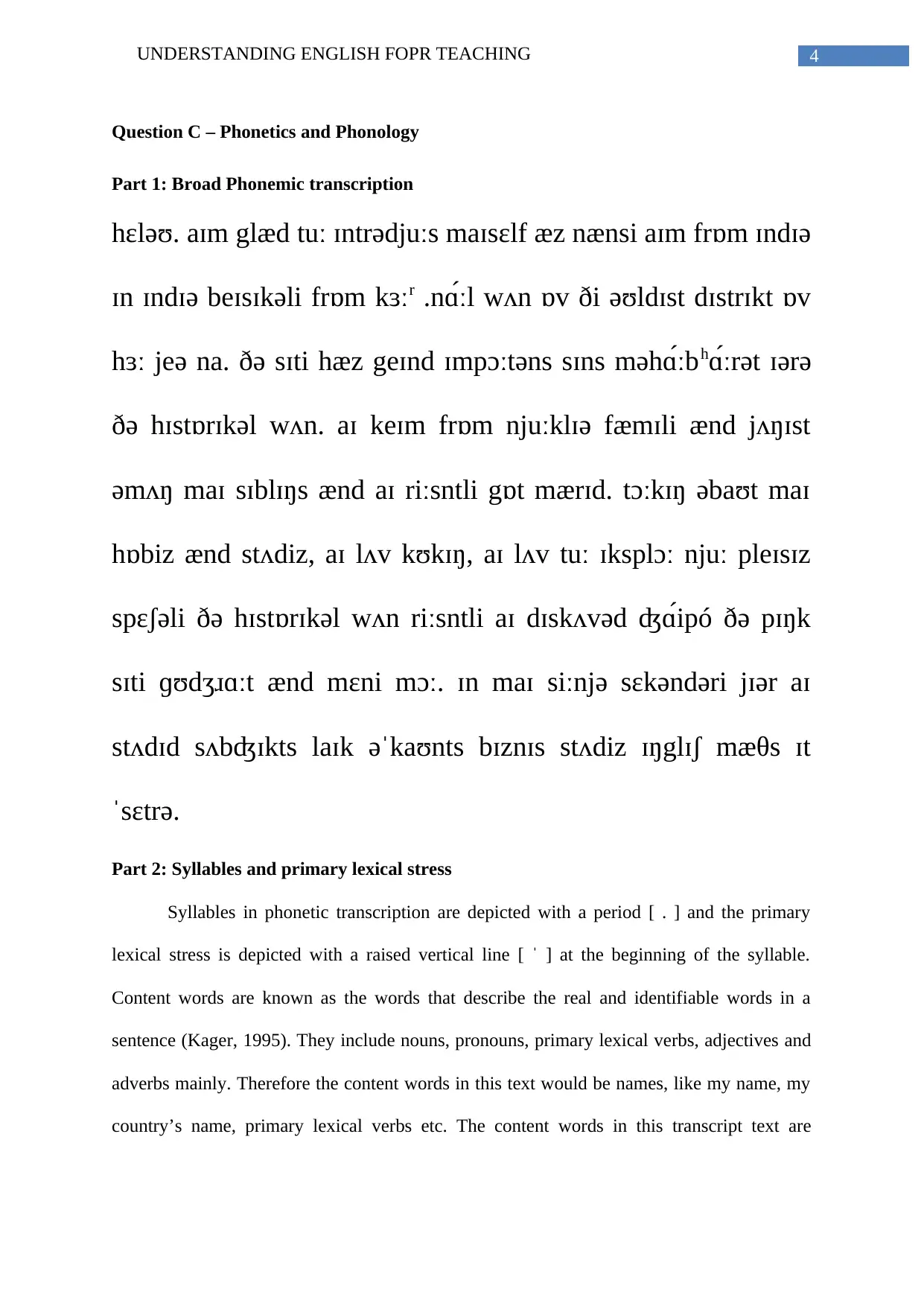
4UNDERSTANDING ENGLISH FOPR TEACHING
Question C – Phonetics and Phonology
Part 1: Broad Phonemic transcription
hɛləʊ. aɪm glæd tuː ɪntrədjuːs maɪsɛlf æz nænsi aɪm frɒm ɪndɪə
ɪn ɪndɪə beɪsɪkəli frɒm kɜːr .nɑ́ːl wʌn ɒv ði əʊldɪst dɪstrɪkt ɒv
hɜː jeə na. ðə sɪti hæz geɪnd ɪmpɔːtəns sɪns məhɑ́ːbhɑ́ːrət ɪərə
ðə hɪstɒrɪkəl wʌn. aɪ keɪm frɒm njuːklɪə fæmɪli ænd jʌŋɪst
əmʌŋ maɪ sɪblɪŋs ænd aɪ riːsntli gɒt mærɪd. tɔːkɪŋ əbaʊt maɪ
hɒbiz ænd stʌdiz, aɪ lʌv kʊkɪŋ, aɪ lʌv tuː ɪksplɔː njuː pleɪsɪz
spɛʃəli ðə hɪstɒrɪkəl wʌn riːsntli aɪ dɪskʌvəd ʤɑ́ipó ðə pɪŋk
sɪti ɡʊdʒɹɑːt ænd mɛni mɔː. ɪn maɪ siːnjə sɛkəndəri jɪər aɪ
stʌdɪd sʌbʤɪkts laɪk əˈkaʊnts bɪznɪs stʌdiz ɪŋglɪʃ mæθs ɪt
ˈsɛtrə.
Part 2: Syllables and primary lexical stress
Syllables in phonetic transcription are depicted with a period [ . ] and the primary
lexical stress is depicted with a raised vertical line [ ˈ ] at the beginning of the syllable.
Content words are known as the words that describe the real and identifiable words in a
sentence (Kager, 1995). They include nouns, pronouns, primary lexical verbs, adjectives and
adverbs mainly. Therefore the content words in this text would be names, like my name, my
country’s name, primary lexical verbs etc. The content words in this transcript text are
Question C – Phonetics and Phonology
Part 1: Broad Phonemic transcription
hɛləʊ. aɪm glæd tuː ɪntrədjuːs maɪsɛlf æz nænsi aɪm frɒm ɪndɪə
ɪn ɪndɪə beɪsɪkəli frɒm kɜːr .nɑ́ːl wʌn ɒv ði əʊldɪst dɪstrɪkt ɒv
hɜː jeə na. ðə sɪti hæz geɪnd ɪmpɔːtəns sɪns məhɑ́ːbhɑ́ːrət ɪərə
ðə hɪstɒrɪkəl wʌn. aɪ keɪm frɒm njuːklɪə fæmɪli ænd jʌŋɪst
əmʌŋ maɪ sɪblɪŋs ænd aɪ riːsntli gɒt mærɪd. tɔːkɪŋ əbaʊt maɪ
hɒbiz ænd stʌdiz, aɪ lʌv kʊkɪŋ, aɪ lʌv tuː ɪksplɔː njuː pleɪsɪz
spɛʃəli ðə hɪstɒrɪkəl wʌn riːsntli aɪ dɪskʌvəd ʤɑ́ipó ðə pɪŋk
sɪti ɡʊdʒɹɑːt ænd mɛni mɔː. ɪn maɪ siːnjə sɛkəndəri jɪər aɪ
stʌdɪd sʌbʤɪkts laɪk əˈkaʊnts bɪznɪs stʌdiz ɪŋglɪʃ mæθs ɪt
ˈsɛtrə.
Part 2: Syllables and primary lexical stress
Syllables in phonetic transcription are depicted with a period [ . ] and the primary
lexical stress is depicted with a raised vertical line [ ˈ ] at the beginning of the syllable.
Content words are known as the words that describe the real and identifiable words in a
sentence (Kager, 1995). They include nouns, pronouns, primary lexical verbs, adjectives and
adverbs mainly. Therefore the content words in this text would be names, like my name, my
country’s name, primary lexical verbs etc. The content words in this transcript text are
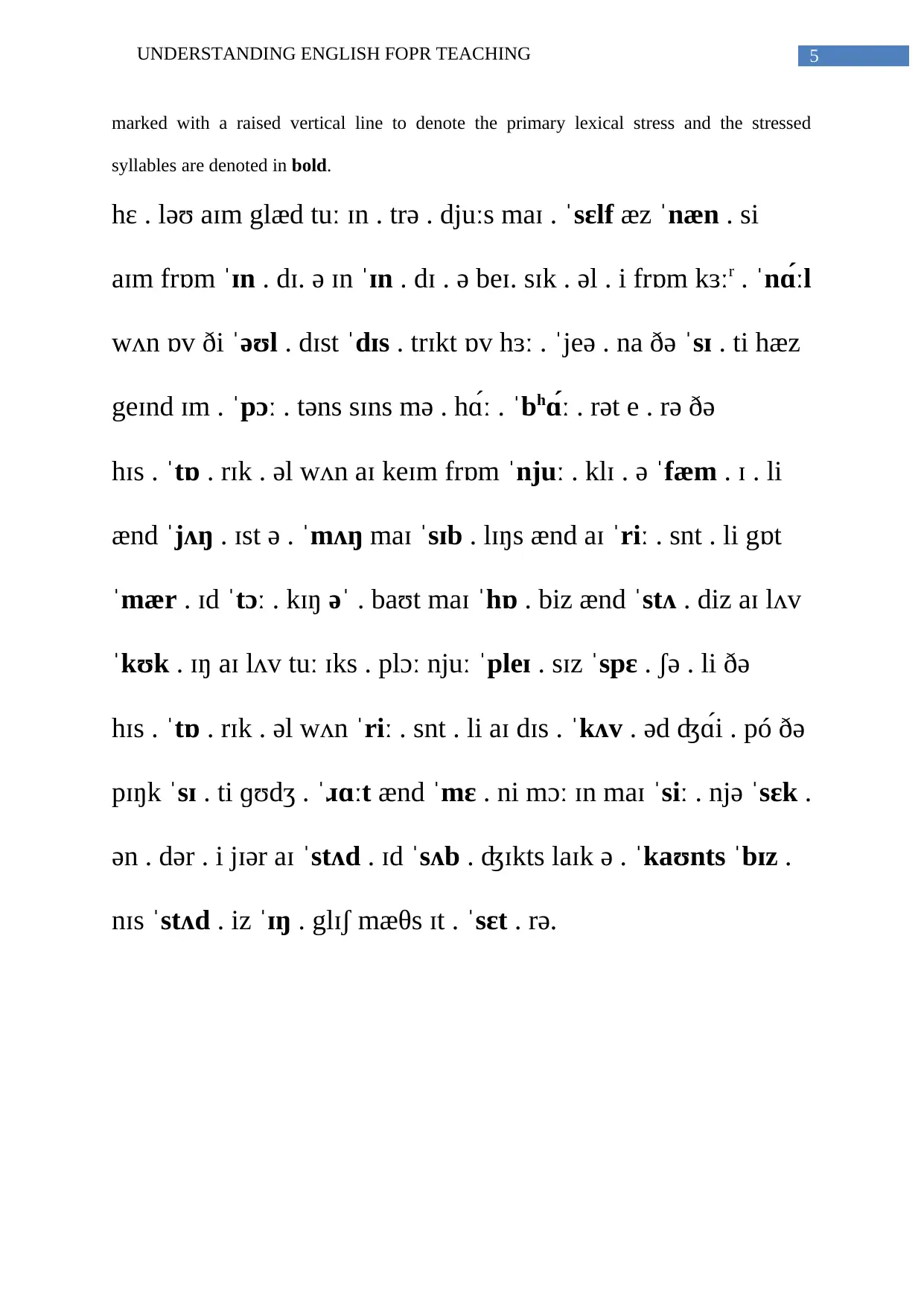
5UNDERSTANDING ENGLISH FOPR TEACHING
marked with a raised vertical line to denote the primary lexical stress and the stressed
syllables are denoted in bold.
hɛ . ləʊ aɪm glæd tuː ɪn . trə . djuːs maɪ . ˈsɛlf æz ˈnæn . si
aɪm frɒm ˈɪn . dɪ. ə ɪn ˈɪn . dɪ . ə beɪ. sɪk . əl . i frɒm kɜːr . ˈnɑ́ːl
wʌn ɒv ði ˈəʊl . dɪst ˈdɪs . trɪkt ɒv hɜː . ˈjeə . na ðə ˈsɪ . ti hæz
geɪnd ɪm . ˈpɔː . təns sɪns mə . hɑ́ː . ˈbhɑ́ː . rət e . rə ðə
hɪs . ˈtɒ . rɪk . əl wʌn aɪ keɪm frɒm ˈnjuː . klɪ . ə ˈfæm . ɪ . li
ænd ˈjʌŋ . ɪst ə . ˈmʌŋ maɪ ˈsɪb . lɪŋs ænd aɪ ˈriː . snt . li gɒt
ˈmær . ɪd ˈtɔː . kɪŋ əˈ . baʊt maɪ ˈhɒ . biz ænd ˈstʌ . diz aɪ lʌv
ˈkʊk . ɪŋ aɪ lʌv tuː ɪks . plɔː njuː ˈpleɪ . sɪz ˈspɛ . ʃə . li ðə
hɪs . ˈtɒ . rɪk . əl wʌn ˈriː . snt . li aɪ dɪs . ˈkʌv . əd ʤɑ́i . pó ðə
pɪŋk ˈsɪ . ti ɡʊdʒ . ˈɹɑːt ænd ˈmɛ . ni mɔː ɪn maɪ ˈsiː . njə ˈsɛk .
ən . dər . i jɪər aɪ ˈstʌd . ɪd ˈsʌb . ʤɪkts laɪk ə . ˈkaʊnts ˈbɪz .
nɪs ˈstʌd . iz ˈɪŋ . glɪʃ mæθs ɪt . ˈsɛt . rə.
marked with a raised vertical line to denote the primary lexical stress and the stressed
syllables are denoted in bold.
hɛ . ləʊ aɪm glæd tuː ɪn . trə . djuːs maɪ . ˈsɛlf æz ˈnæn . si
aɪm frɒm ˈɪn . dɪ. ə ɪn ˈɪn . dɪ . ə beɪ. sɪk . əl . i frɒm kɜːr . ˈnɑ́ːl
wʌn ɒv ði ˈəʊl . dɪst ˈdɪs . trɪkt ɒv hɜː . ˈjeə . na ðə ˈsɪ . ti hæz
geɪnd ɪm . ˈpɔː . təns sɪns mə . hɑ́ː . ˈbhɑ́ː . rət e . rə ðə
hɪs . ˈtɒ . rɪk . əl wʌn aɪ keɪm frɒm ˈnjuː . klɪ . ə ˈfæm . ɪ . li
ænd ˈjʌŋ . ɪst ə . ˈmʌŋ maɪ ˈsɪb . lɪŋs ænd aɪ ˈriː . snt . li gɒt
ˈmær . ɪd ˈtɔː . kɪŋ əˈ . baʊt maɪ ˈhɒ . biz ænd ˈstʌ . diz aɪ lʌv
ˈkʊk . ɪŋ aɪ lʌv tuː ɪks . plɔː njuː ˈpleɪ . sɪz ˈspɛ . ʃə . li ðə
hɪs . ˈtɒ . rɪk . əl wʌn ˈriː . snt . li aɪ dɪs . ˈkʌv . əd ʤɑ́i . pó ðə
pɪŋk ˈsɪ . ti ɡʊdʒ . ˈɹɑːt ænd ˈmɛ . ni mɔː ɪn maɪ ˈsiː . njə ˈsɛk .
ən . dər . i jɪər aɪ ˈstʌd . ɪd ˈsʌb . ʤɪkts laɪk ə . ˈkaʊnts ˈbɪz .
nɪs ˈstʌd . iz ˈɪŋ . glɪʃ mæθs ɪt . ˈsɛt . rə.
⊘ This is a preview!⊘
Do you want full access?
Subscribe today to unlock all pages.

Trusted by 1+ million students worldwide
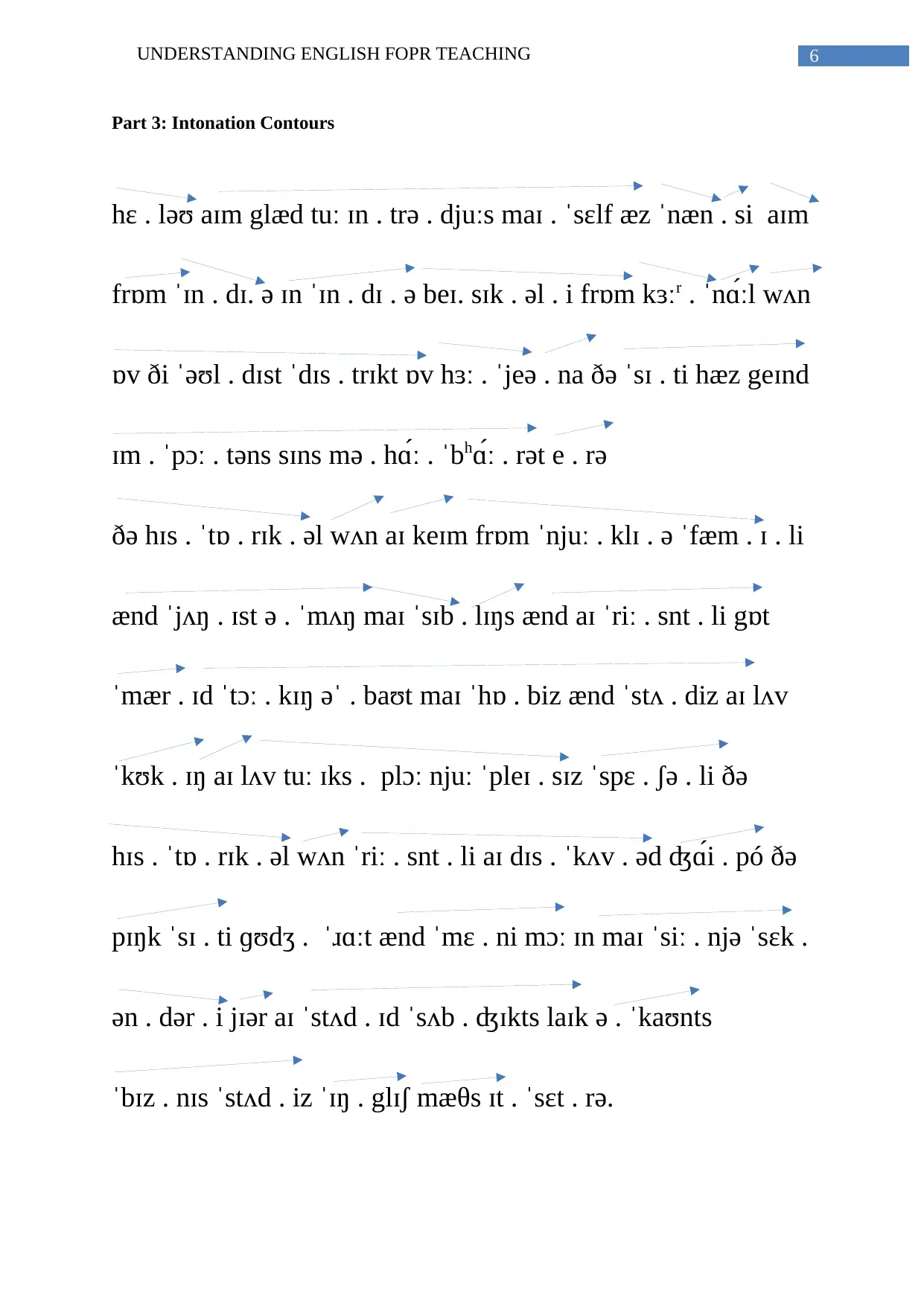
6UNDERSTANDING ENGLISH FOPR TEACHING
Part 3: Intonation Contours
hɛ . ləʊ aɪm glæd tuː ɪn . trə . djuːs maɪ . ˈsɛlf æz ˈnæn . si aɪm
frɒm ˈɪn . dɪ. ə ɪn ˈɪn . dɪ . ə beɪ. sɪk . əl . i frɒm kɜːr . ˈnɑ́ːl wʌn
ɒv ði ˈəʊl . dɪst ˈdɪs . trɪkt ɒv hɜː . ˈjeə . na ðə ˈsɪ . ti hæz geɪnd
ɪm . ˈpɔː . təns sɪns mə . hɑ́ː . ˈbhɑ́ː . rət e . rə
ðə hɪs . ˈtɒ . rɪk . əl wʌn aɪ keɪm frɒm ˈnjuː . klɪ . ə ˈfæm . ɪ . li
ænd ˈjʌŋ . ɪst ə . ˈmʌŋ maɪ ˈsɪb . lɪŋs ænd aɪ ˈriː . snt . li gɒt
ˈmær . ɪd ˈtɔː . kɪŋ əˈ . baʊt maɪ ˈhɒ . biz ænd ˈstʌ . diz aɪ lʌv
ˈkʊk . ɪŋ aɪ lʌv tuː ɪks . plɔː njuː ˈpleɪ . sɪz ˈspɛ . ʃə . li ðə
hɪs . ˈtɒ . rɪk . əl wʌn ˈriː . snt . li aɪ dɪs . ˈkʌv . əd ʤɑ́i . pó ðə
pɪŋk ˈsɪ . ti ɡʊdʒ . ˈɹɑːt ænd ˈmɛ . ni mɔː ɪn maɪ ˈsiː . njə ˈsɛk .
ən . dər . i jɪər aɪ ˈstʌd . ɪd ˈsʌb . ʤɪkts laɪk ə . ˈkaʊnts
ˈbɪz . nɪs ˈstʌd . iz ˈɪŋ . glɪʃ mæθs ɪt . ˈsɛt . rə.
Part 3: Intonation Contours
hɛ . ləʊ aɪm glæd tuː ɪn . trə . djuːs maɪ . ˈsɛlf æz ˈnæn . si aɪm
frɒm ˈɪn . dɪ. ə ɪn ˈɪn . dɪ . ə beɪ. sɪk . əl . i frɒm kɜːr . ˈnɑ́ːl wʌn
ɒv ði ˈəʊl . dɪst ˈdɪs . trɪkt ɒv hɜː . ˈjeə . na ðə ˈsɪ . ti hæz geɪnd
ɪm . ˈpɔː . təns sɪns mə . hɑ́ː . ˈbhɑ́ː . rət e . rə
ðə hɪs . ˈtɒ . rɪk . əl wʌn aɪ keɪm frɒm ˈnjuː . klɪ . ə ˈfæm . ɪ . li
ænd ˈjʌŋ . ɪst ə . ˈmʌŋ maɪ ˈsɪb . lɪŋs ænd aɪ ˈriː . snt . li gɒt
ˈmær . ɪd ˈtɔː . kɪŋ əˈ . baʊt maɪ ˈhɒ . biz ænd ˈstʌ . diz aɪ lʌv
ˈkʊk . ɪŋ aɪ lʌv tuː ɪks . plɔː njuː ˈpleɪ . sɪz ˈspɛ . ʃə . li ðə
hɪs . ˈtɒ . rɪk . əl wʌn ˈriː . snt . li aɪ dɪs . ˈkʌv . əd ʤɑ́i . pó ðə
pɪŋk ˈsɪ . ti ɡʊdʒ . ˈɹɑːt ænd ˈmɛ . ni mɔː ɪn maɪ ˈsiː . njə ˈsɛk .
ən . dər . i jɪər aɪ ˈstʌd . ɪd ˈsʌb . ʤɪkts laɪk ə . ˈkaʊnts
ˈbɪz . nɪs ˈstʌd . iz ˈɪŋ . glɪʃ mæθs ɪt . ˈsɛt . rə.
Paraphrase This Document
Need a fresh take? Get an instant paraphrase of this document with our AI Paraphraser
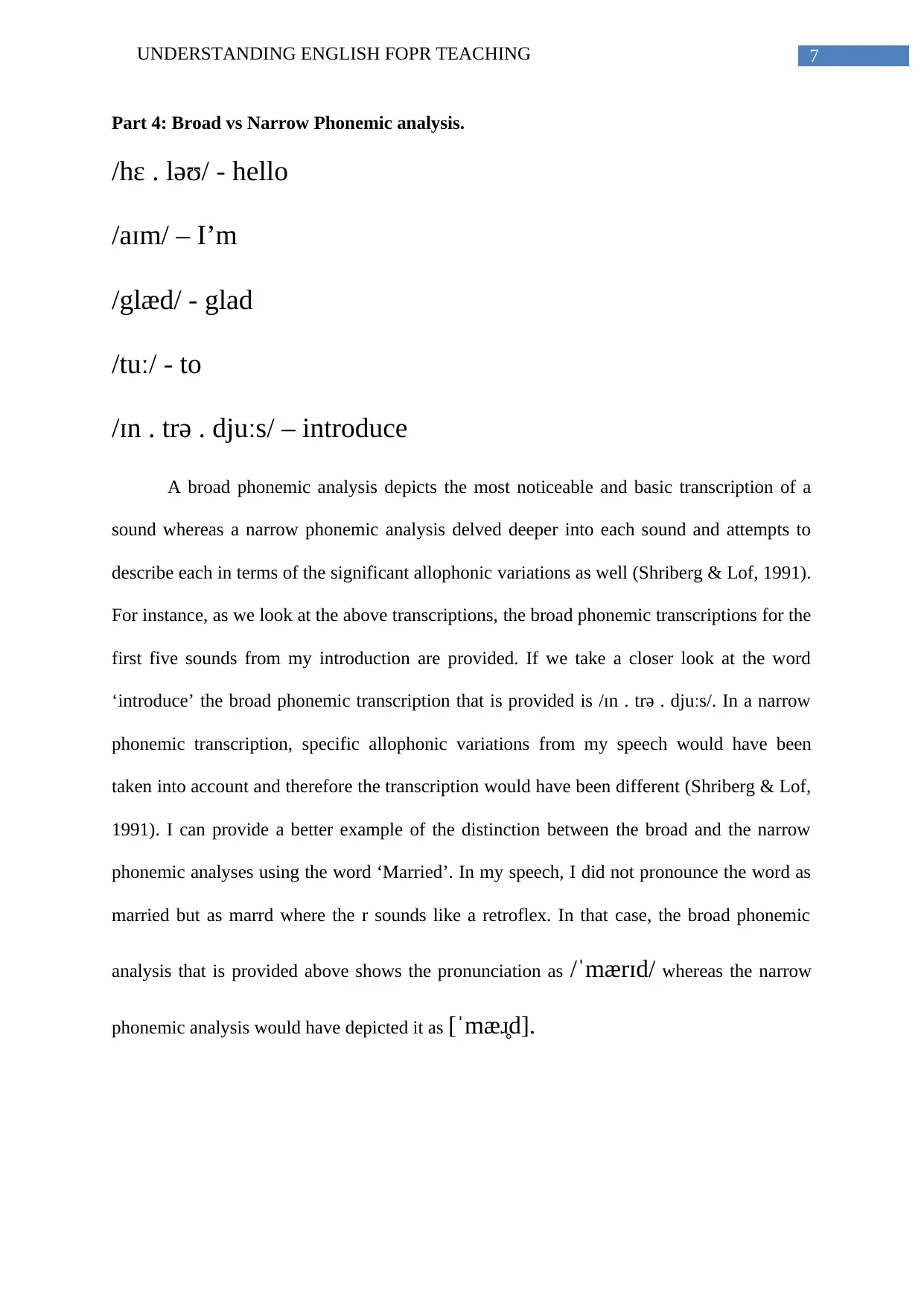
7UNDERSTANDING ENGLISH FOPR TEACHING
Part 4: Broad vs Narrow Phonemic analysis.
/hɛ . ləʊ/ - hello
/aɪm/ – I’m
/glæd/ - glad
/tuː/ - to
/ɪn . trə . djuːs/ – introduce
A broad phonemic analysis depicts the most noticeable and basic transcription of a
sound whereas a narrow phonemic analysis delved deeper into each sound and attempts to
describe each in terms of the significant allophonic variations as well (Shriberg & Lof, 1991).
For instance, as we look at the above transcriptions, the broad phonemic transcriptions for the
first five sounds from my introduction are provided. If we take a closer look at the word
‘introduce’ the broad phonemic transcription that is provided is /ɪn . trə . djuːs/. In a narrow
phonemic transcription, specific allophonic variations from my speech would have been
taken into account and therefore the transcription would have been different (Shriberg & Lof,
1991). I can provide a better example of the distinction between the broad and the narrow
phonemic analyses using the word ‘Married’. In my speech, I did not pronounce the word as
married but as marrd where the r sounds like a retroflex. In that case, the broad phonemic
analysis that is provided above shows the pronunciation as /ˈmærɪd/ whereas the narrow
phonemic analysis would have depicted it as [ˈmæɹ̥d].
Part 4: Broad vs Narrow Phonemic analysis.
/hɛ . ləʊ/ - hello
/aɪm/ – I’m
/glæd/ - glad
/tuː/ - to
/ɪn . trə . djuːs/ – introduce
A broad phonemic analysis depicts the most noticeable and basic transcription of a
sound whereas a narrow phonemic analysis delved deeper into each sound and attempts to
describe each in terms of the significant allophonic variations as well (Shriberg & Lof, 1991).
For instance, as we look at the above transcriptions, the broad phonemic transcriptions for the
first five sounds from my introduction are provided. If we take a closer look at the word
‘introduce’ the broad phonemic transcription that is provided is /ɪn . trə . djuːs/. In a narrow
phonemic transcription, specific allophonic variations from my speech would have been
taken into account and therefore the transcription would have been different (Shriberg & Lof,
1991). I can provide a better example of the distinction between the broad and the narrow
phonemic analyses using the word ‘Married’. In my speech, I did not pronounce the word as
married but as marrd where the r sounds like a retroflex. In that case, the broad phonemic
analysis that is provided above shows the pronunciation as /ˈmærɪd/ whereas the narrow
phonemic analysis would have depicted it as [ˈmæɹ̥d].

8UNDERSTANDING ENGLISH FOPR TEACHING
Part 5: Suprasegmental feature – activity.
The suprasegmental feature that I am focusing on is sentence or phrase stress in
speech. Sentence stress in speech is used to denote a particular meaning to the speech. As
Fromkin, Rodman and Hyams (2018, p. 320) explains, a sentence can have variable meaning
based on the word that is stressed in the sentence. For example, let us take the example from
the text that I have transcribed above, a phrase like ‘one of the oldest districts of Haryana’
can have different senses attributed to it. A stress on the word ‘one’ indicates that the place
being referred to is one of the many oldest places in Haryana, whereas a stress on the word
‘Haryana’ means that there may be many old places in the country but the one that is referred
to here is in Haryana.
Based on that concept, the following activity is designed to teach sentence stress to
the learners. This is a group based activity which is tailored to meet the communicative
competence requirement of the learners. Communicative competence is a highlight of all
upcoming activates, therefore I am providing a background information about the concept in
this section.
Communicative competence is a concept that indicates towards the grammatical
ability of a person. The term was coined by Dell Hymes in 1966 (Hymes, 1972) and draws a
contrast between Chomsky’s concepts of linguistic competence and performance. It
underpins that the competence in communication is developed based on the learner’s
knowledge of grammatical features as well as their ability to use those features in a social
situation.
Firstly, teach the learners the concept of sentence stress and give them an example
sentence on the board:
“I will have her killed if you fail the task”
Part 5: Suprasegmental feature – activity.
The suprasegmental feature that I am focusing on is sentence or phrase stress in
speech. Sentence stress in speech is used to denote a particular meaning to the speech. As
Fromkin, Rodman and Hyams (2018, p. 320) explains, a sentence can have variable meaning
based on the word that is stressed in the sentence. For example, let us take the example from
the text that I have transcribed above, a phrase like ‘one of the oldest districts of Haryana’
can have different senses attributed to it. A stress on the word ‘one’ indicates that the place
being referred to is one of the many oldest places in Haryana, whereas a stress on the word
‘Haryana’ means that there may be many old places in the country but the one that is referred
to here is in Haryana.
Based on that concept, the following activity is designed to teach sentence stress to
the learners. This is a group based activity which is tailored to meet the communicative
competence requirement of the learners. Communicative competence is a highlight of all
upcoming activates, therefore I am providing a background information about the concept in
this section.
Communicative competence is a concept that indicates towards the grammatical
ability of a person. The term was coined by Dell Hymes in 1966 (Hymes, 1972) and draws a
contrast between Chomsky’s concepts of linguistic competence and performance. It
underpins that the competence in communication is developed based on the learner’s
knowledge of grammatical features as well as their ability to use those features in a social
situation.
Firstly, teach the learners the concept of sentence stress and give them an example
sentence on the board:
“I will have her killed if you fail the task”
⊘ This is a preview!⊘
Do you want full access?
Subscribe today to unlock all pages.

Trusted by 1+ million students worldwide
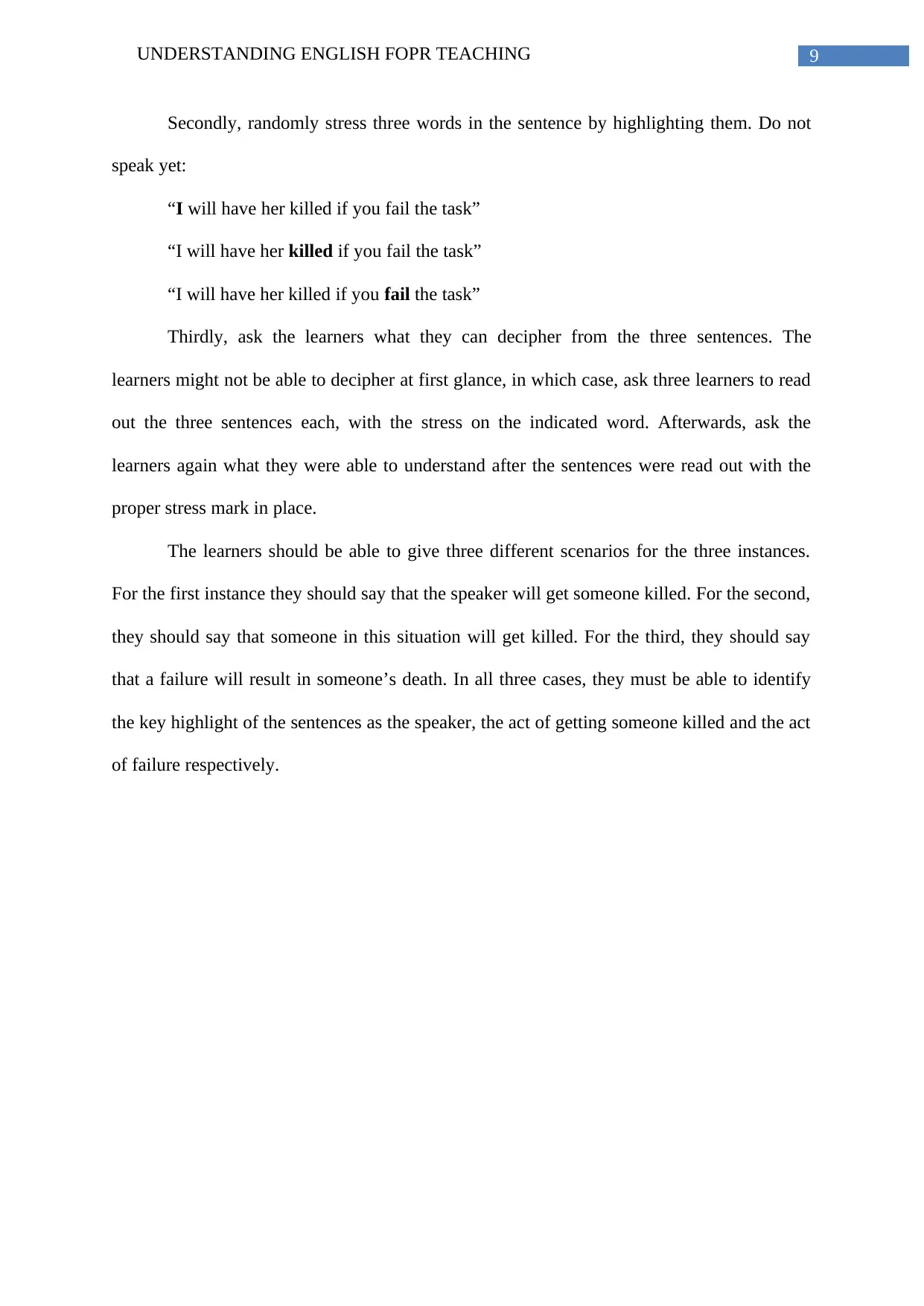
9UNDERSTANDING ENGLISH FOPR TEACHING
Secondly, randomly stress three words in the sentence by highlighting them. Do not
speak yet:
“I will have her killed if you fail the task”
“I will have her killed if you fail the task”
“I will have her killed if you fail the task”
Thirdly, ask the learners what they can decipher from the three sentences. The
learners might not be able to decipher at first glance, in which case, ask three learners to read
out the three sentences each, with the stress on the indicated word. Afterwards, ask the
learners again what they were able to understand after the sentences were read out with the
proper stress mark in place.
The learners should be able to give three different scenarios for the three instances.
For the first instance they should say that the speaker will get someone killed. For the second,
they should say that someone in this situation will get killed. For the third, they should say
that a failure will result in someone’s death. In all three cases, they must be able to identify
the key highlight of the sentences as the speaker, the act of getting someone killed and the act
of failure respectively.
Secondly, randomly stress three words in the sentence by highlighting them. Do not
speak yet:
“I will have her killed if you fail the task”
“I will have her killed if you fail the task”
“I will have her killed if you fail the task”
Thirdly, ask the learners what they can decipher from the three sentences. The
learners might not be able to decipher at first glance, in which case, ask three learners to read
out the three sentences each, with the stress on the indicated word. Afterwards, ask the
learners again what they were able to understand after the sentences were read out with the
proper stress mark in place.
The learners should be able to give three different scenarios for the three instances.
For the first instance they should say that the speaker will get someone killed. For the second,
they should say that someone in this situation will get killed. For the third, they should say
that a failure will result in someone’s death. In all three cases, they must be able to identify
the key highlight of the sentences as the speaker, the act of getting someone killed and the act
of failure respectively.
Paraphrase This Document
Need a fresh take? Get an instant paraphrase of this document with our AI Paraphraser
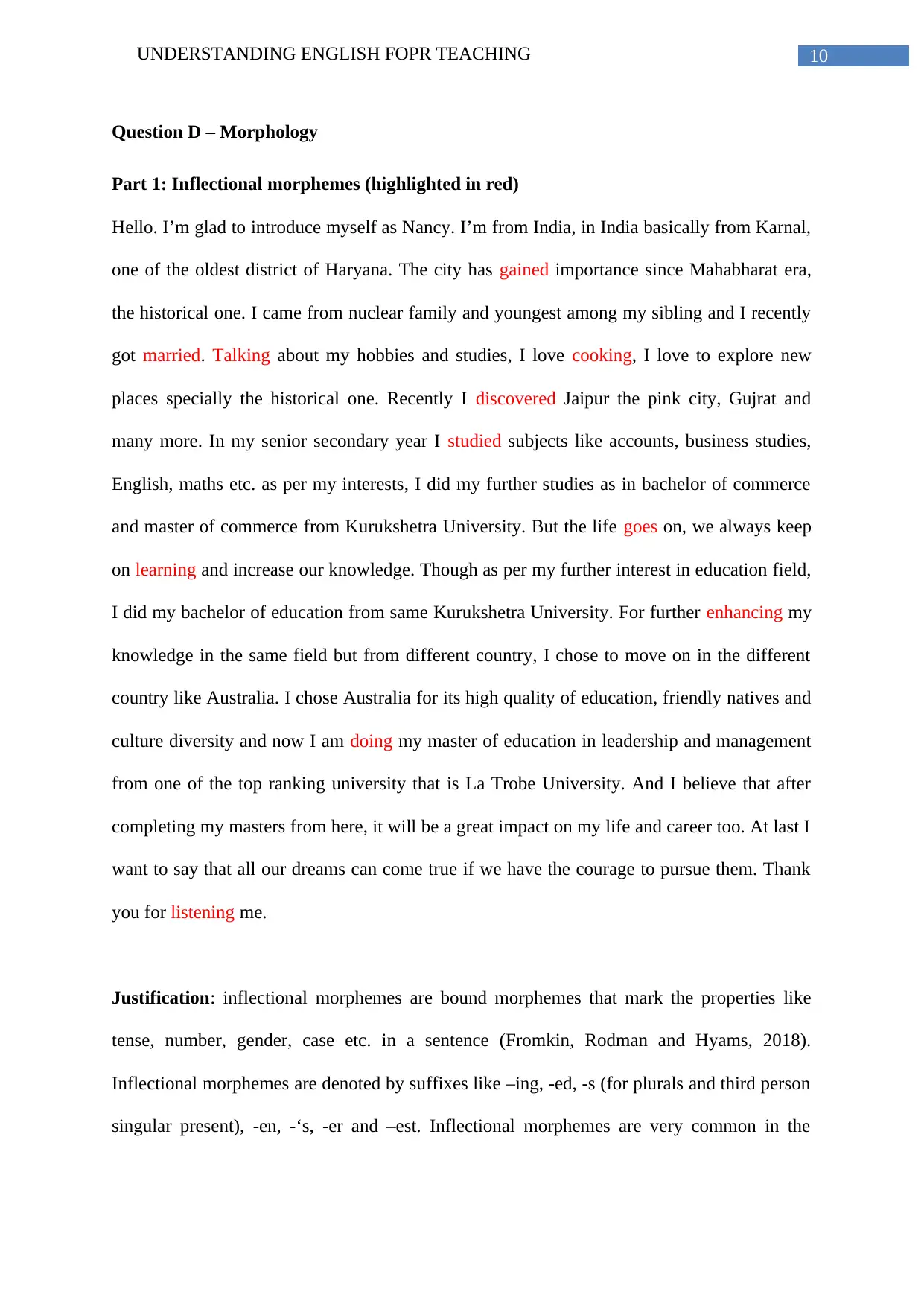
10UNDERSTANDING ENGLISH FOPR TEACHING
Question D – Morphology
Part 1: Inflectional morphemes (highlighted in red)
Hello. I’m glad to introduce myself as Nancy. I’m from India, in India basically from Karnal,
one of the oldest district of Haryana. The city has gained importance since Mahabharat era,
the historical one. I came from nuclear family and youngest among my sibling and I recently
got married. Talking about my hobbies and studies, I love cooking, I love to explore new
places specially the historical one. Recently I discovered Jaipur the pink city, Gujrat and
many more. In my senior secondary year I studied subjects like accounts, business studies,
English, maths etc. as per my interests, I did my further studies as in bachelor of commerce
and master of commerce from Kurukshetra University. But the life goes on, we always keep
on learning and increase our knowledge. Though as per my further interest in education field,
I did my bachelor of education from same Kurukshetra University. For further enhancing my
knowledge in the same field but from different country, I chose to move on in the different
country like Australia. I chose Australia for its high quality of education, friendly natives and
culture diversity and now I am doing my master of education in leadership and management
from one of the top ranking university that is La Trobe University. And I believe that after
completing my masters from here, it will be a great impact on my life and career too. At last I
want to say that all our dreams can come true if we have the courage to pursue them. Thank
you for listening me.
Justification: inflectional morphemes are bound morphemes that mark the properties like
tense, number, gender, case etc. in a sentence (Fromkin, Rodman and Hyams, 2018).
Inflectional morphemes are denoted by suffixes like –ing, -ed, -s (for plurals and third person
singular present), -en, -‘s, -er and –est. Inflectional morphemes are very common in the
Question D – Morphology
Part 1: Inflectional morphemes (highlighted in red)
Hello. I’m glad to introduce myself as Nancy. I’m from India, in India basically from Karnal,
one of the oldest district of Haryana. The city has gained importance since Mahabharat era,
the historical one. I came from nuclear family and youngest among my sibling and I recently
got married. Talking about my hobbies and studies, I love cooking, I love to explore new
places specially the historical one. Recently I discovered Jaipur the pink city, Gujrat and
many more. In my senior secondary year I studied subjects like accounts, business studies,
English, maths etc. as per my interests, I did my further studies as in bachelor of commerce
and master of commerce from Kurukshetra University. But the life goes on, we always keep
on learning and increase our knowledge. Though as per my further interest in education field,
I did my bachelor of education from same Kurukshetra University. For further enhancing my
knowledge in the same field but from different country, I chose to move on in the different
country like Australia. I chose Australia for its high quality of education, friendly natives and
culture diversity and now I am doing my master of education in leadership and management
from one of the top ranking university that is La Trobe University. And I believe that after
completing my masters from here, it will be a great impact on my life and career too. At last I
want to say that all our dreams can come true if we have the courage to pursue them. Thank
you for listening me.
Justification: inflectional morphemes are bound morphemes that mark the properties like
tense, number, gender, case etc. in a sentence (Fromkin, Rodman and Hyams, 2018).
Inflectional morphemes are denoted by suffixes like –ing, -ed, -s (for plurals and third person
singular present), -en, -‘s, -er and –est. Inflectional morphemes are very common in the
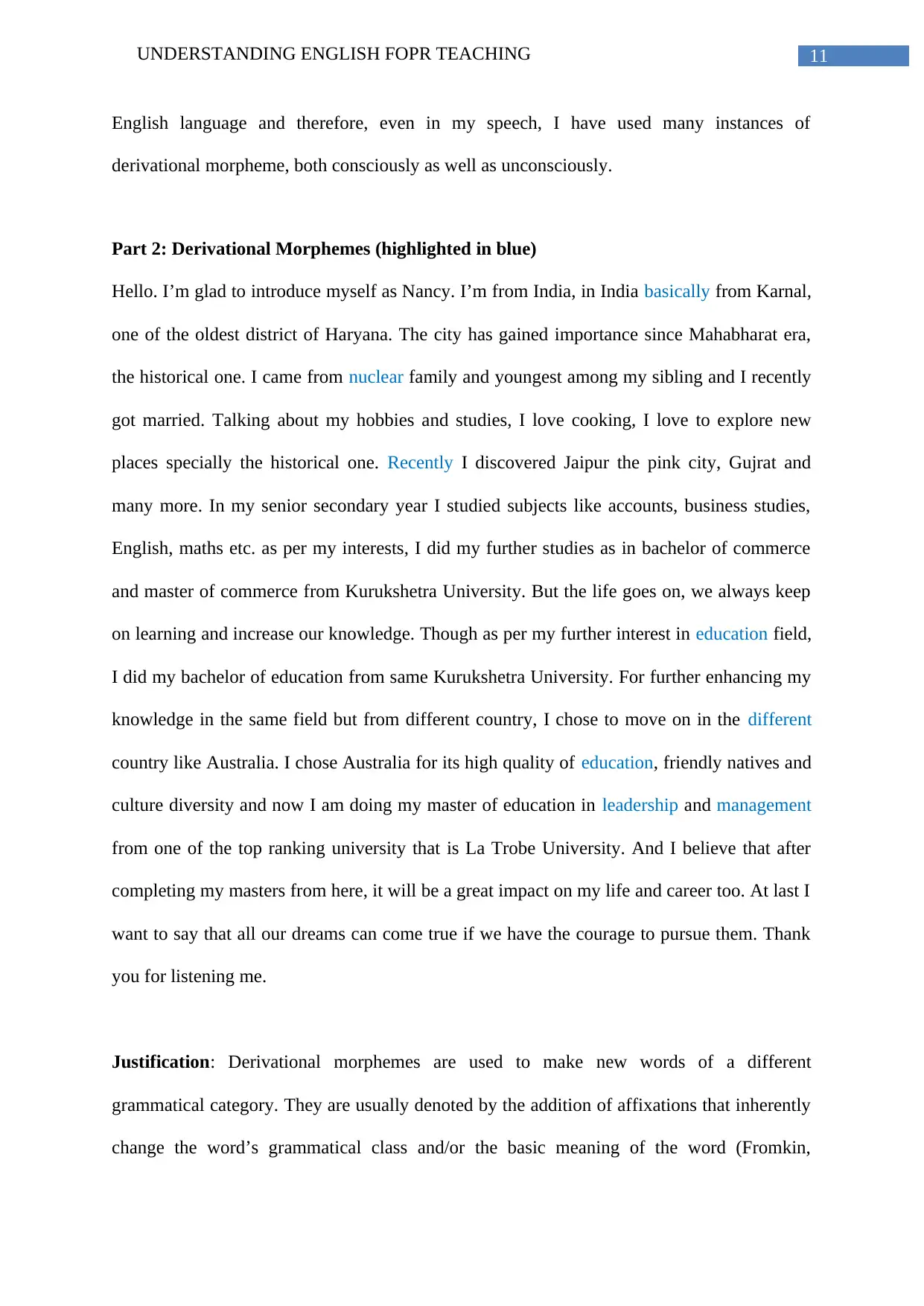
11UNDERSTANDING ENGLISH FOPR TEACHING
English language and therefore, even in my speech, I have used many instances of
derivational morpheme, both consciously as well as unconsciously.
Part 2: Derivational Morphemes (highlighted in blue)
Hello. I’m glad to introduce myself as Nancy. I’m from India, in India basically from Karnal,
one of the oldest district of Haryana. The city has gained importance since Mahabharat era,
the historical one. I came from nuclear family and youngest among my sibling and I recently
got married. Talking about my hobbies and studies, I love cooking, I love to explore new
places specially the historical one. Recently I discovered Jaipur the pink city, Gujrat and
many more. In my senior secondary year I studied subjects like accounts, business studies,
English, maths etc. as per my interests, I did my further studies as in bachelor of commerce
and master of commerce from Kurukshetra University. But the life goes on, we always keep
on learning and increase our knowledge. Though as per my further interest in education field,
I did my bachelor of education from same Kurukshetra University. For further enhancing my
knowledge in the same field but from different country, I chose to move on in the different
country like Australia. I chose Australia for its high quality of education, friendly natives and
culture diversity and now I am doing my master of education in leadership and management
from one of the top ranking university that is La Trobe University. And I believe that after
completing my masters from here, it will be a great impact on my life and career too. At last I
want to say that all our dreams can come true if we have the courage to pursue them. Thank
you for listening me.
Justification: Derivational morphemes are used to make new words of a different
grammatical category. They are usually denoted by the addition of affixations that inherently
change the word’s grammatical class and/or the basic meaning of the word (Fromkin,
English language and therefore, even in my speech, I have used many instances of
derivational morpheme, both consciously as well as unconsciously.
Part 2: Derivational Morphemes (highlighted in blue)
Hello. I’m glad to introduce myself as Nancy. I’m from India, in India basically from Karnal,
one of the oldest district of Haryana. The city has gained importance since Mahabharat era,
the historical one. I came from nuclear family and youngest among my sibling and I recently
got married. Talking about my hobbies and studies, I love cooking, I love to explore new
places specially the historical one. Recently I discovered Jaipur the pink city, Gujrat and
many more. In my senior secondary year I studied subjects like accounts, business studies,
English, maths etc. as per my interests, I did my further studies as in bachelor of commerce
and master of commerce from Kurukshetra University. But the life goes on, we always keep
on learning and increase our knowledge. Though as per my further interest in education field,
I did my bachelor of education from same Kurukshetra University. For further enhancing my
knowledge in the same field but from different country, I chose to move on in the different
country like Australia. I chose Australia for its high quality of education, friendly natives and
culture diversity and now I am doing my master of education in leadership and management
from one of the top ranking university that is La Trobe University. And I believe that after
completing my masters from here, it will be a great impact on my life and career too. At last I
want to say that all our dreams can come true if we have the courage to pursue them. Thank
you for listening me.
Justification: Derivational morphemes are used to make new words of a different
grammatical category. They are usually denoted by the addition of affixations that inherently
change the word’s grammatical class and/or the basic meaning of the word (Fromkin,
⊘ This is a preview!⊘
Do you want full access?
Subscribe today to unlock all pages.

Trusted by 1+ million students worldwide
1 out of 31
Your All-in-One AI-Powered Toolkit for Academic Success.
+13062052269
info@desklib.com
Available 24*7 on WhatsApp / Email
![[object Object]](/_next/static/media/star-bottom.7253800d.svg)
Unlock your academic potential
Copyright © 2020–2025 A2Z Services. All Rights Reserved. Developed and managed by ZUCOL.
